Happy New Year!
Enterning the Fjord
2 weeks ago
Daily illustrated photo tips by Jeff Wignall, author of "The Photographer's Master Guide to Color."
 Ok, well, unless you're living in Dubai or a member of some royal family, I guess the yacht is not on the inexpensive last-minute gift list. But good news, there are lots of fun and inexpensive things that the photographers in your life will love (and thank you for later!). Here are 10 that I am sure anyone would love to get:
Ok, well, unless you're living in Dubai or a member of some royal family, I guess the yacht is not on the inexpensive last-minute gift list. But good news, there are lots of fun and inexpensive things that the photographers in your life will love (and thank you for later!). Here are 10 that I am sure anyone would love to get: I love to take pictures of lighted signs at night because there is something very visually exciting about that pure and highly saturated color against the dark of night. Another of the fun things about shooting signs is that they are one of the few subjects that really call out to be composed in a completely abstract way. Unless you're photographing a neon sign that makes more sense as a whole (it spells out a classic neon word like "Diner," for example), there is really no reason to even include the entire sign. Instead, look for patterns of light and shapes and colors that have their own visual rhythm. I photographed the sign here at a carnival, for example, and I don't even recall what the sign said--and I don't think I shot a single frame of the complete sign. But I got fascinated by interplay of shapes and colors and the flow of the swirling script.
I love to take pictures of lighted signs at night because there is something very visually exciting about that pure and highly saturated color against the dark of night. Another of the fun things about shooting signs is that they are one of the few subjects that really call out to be composed in a completely abstract way. Unless you're photographing a neon sign that makes more sense as a whole (it spells out a classic neon word like "Diner," for example), there is really no reason to even include the entire sign. Instead, look for patterns of light and shapes and colors that have their own visual rhythm. I photographed the sign here at a carnival, for example, and I don't even recall what the sign said--and I don't think I shot a single frame of the complete sign. But I got fascinated by interplay of shapes and colors and the flow of the swirling script. One of the questions that I hear a lot from folks that are new to digital cameras is: "Why do parts of my images flash at me when I'm reviewing photos on the LCD?" The answer is because they have inadvertently turned on the highlight warning or "clipping" warning. Clipping is a term used in digital photography that essentially means the highlights are burned out and that there is no recognizable detail in those areas. Most digital cameras (at least most DSLRs) have a feature that you can turn on or off that flashes to warn you that you have overexposed areas; typically these clipped highlights flash as small dark patches wherever there is a total loss of highlight detail.
One of the questions that I hear a lot from folks that are new to digital cameras is: "Why do parts of my images flash at me when I'm reviewing photos on the LCD?" The answer is because they have inadvertently turned on the highlight warning or "clipping" warning. Clipping is a term used in digital photography that essentially means the highlights are burned out and that there is no recognizable detail in those areas. Most digital cameras (at least most DSLRs) have a feature that you can turn on or off that flashes to warn you that you have overexposed areas; typically these clipped highlights flash as small dark patches wherever there is a total loss of highlight detail. In a previous tip I talked about looking for high vantage points for landscapes and other wide shots, but the idea is just as useful for smaller subjects, particularly garden photos. A few years ago after realizing that I was shooting all of my garden photos from approximately the same height (coincidentally, my eye level), I decided that varying the angle more might add some variety to my shots. I do a lot of garden shots laying on my stomach or my side already, so what was missing was height. I tried some shots with a 6' step ladder and for some shots, particularly wide shots of entire garden beds, that worked fine, but the angle was too steep for closer shots of smaller areas. It looked like a giant had been shooting the photos (though I have shot some photos of my garden from a second-story bedroom window and they look kind of cool).
In a previous tip I talked about looking for high vantage points for landscapes and other wide shots, but the idea is just as useful for smaller subjects, particularly garden photos. A few years ago after realizing that I was shooting all of my garden photos from approximately the same height (coincidentally, my eye level), I decided that varying the angle more might add some variety to my shots. I do a lot of garden shots laying on my stomach or my side already, so what was missing was height. I tried some shots with a 6' step ladder and for some shots, particularly wide shots of entire garden beds, that worked fine, but the angle was too steep for closer shots of smaller areas. It looked like a giant had been shooting the photos (though I have shot some photos of my garden from a second-story bedroom window and they look kind of cool). Just a quick interim tip to remind you that you can follow this blog via your Google account. All this really means is that you will see updates from the blog on your Google Dashboard page (to remind you that I'm still out here typing away!). This blog is, and will always be, totally free. I make some small amount (tiny) from clicks on the ads on the blog and if you order something from Amazon and start by clicking one of my Amazon ads (the ads are just a gateway to Amazon, you can order anything in any department--you *don't* even have to be interested in the product that's in the ad), but other than that, I write the tips for the fun of it and because it helps keep me focused. I'm my own therapist (hey, who knows me better?). Anyway, I have a lot of new readers lately and so about once every few months I just ask that readers put me on their follow list. It helps me to know how many people are reading this or if I'm just writing to myself. And don't forget you can always email me or leave a comment requesting certain topics--shooting or Photoshop/editing.
Just a quick interim tip to remind you that you can follow this blog via your Google account. All this really means is that you will see updates from the blog on your Google Dashboard page (to remind you that I'm still out here typing away!). This blog is, and will always be, totally free. I make some small amount (tiny) from clicks on the ads on the blog and if you order something from Amazon and start by clicking one of my Amazon ads (the ads are just a gateway to Amazon, you can order anything in any department--you *don't* even have to be interested in the product that's in the ad), but other than that, I write the tips for the fun of it and because it helps keep me focused. I'm my own therapist (hey, who knows me better?). Anyway, I have a lot of new readers lately and so about once every few months I just ask that readers put me on their follow list. It helps me to know how many people are reading this or if I'm just writing to myself. And don't forget you can always email me or leave a comment requesting certain topics--shooting or Photoshop/editing. Sometimes the best landscape tips are the simplest ones--like looking for a high vantage point. It's amazing how different a scene can look if you can just get above it a bit. I was pretty lucky with this shot of the Camden, Maine harbor because there is a hill next to the harbor--you can pretty much sit on a park bench and get this shot. But I've also shot the same harbor from the back deck of a nearby gift shop (The Smiling Cow, if you happen to be headed up that way) and from the balcony of a hotel. There are also some elevated views of the harbor from a nearby public parking lot. While it's not always possible to find a higher viewpoint, it's worth scouting around a bit. I remember spending a frustrating day trying to get a good shot of the Breakers mansion and its grounds in Newport one summer day and finally decided to go inside and take the tour and wait for an idea to come to me--and it did. During the tour they took us out to a second story portico and from there the entire grounds of the estate and the ocean behind it came into clear view. Duh! It hadn't occurred to me that the best shot of the setting was from the building rather than looking at it. When you're shooting a landscape, look up, and then ask yourself how you can get to a higher perch.
Sometimes the best landscape tips are the simplest ones--like looking for a high vantage point. It's amazing how different a scene can look if you can just get above it a bit. I was pretty lucky with this shot of the Camden, Maine harbor because there is a hill next to the harbor--you can pretty much sit on a park bench and get this shot. But I've also shot the same harbor from the back deck of a nearby gift shop (The Smiling Cow, if you happen to be headed up that way) and from the balcony of a hotel. There are also some elevated views of the harbor from a nearby public parking lot. While it's not always possible to find a higher viewpoint, it's worth scouting around a bit. I remember spending a frustrating day trying to get a good shot of the Breakers mansion and its grounds in Newport one summer day and finally decided to go inside and take the tour and wait for an idea to come to me--and it did. During the tour they took us out to a second story portico and from there the entire grounds of the estate and the ocean behind it came into clear view. Duh! It hadn't occurred to me that the best shot of the setting was from the building rather than looking at it. When you're shooting a landscape, look up, and then ask yourself how you can get to a higher perch.
 No matter where you live, small town or big city, chances are that some of the greatest artwork in your community exists in the churches, mosques and temples that you drive past every day. Unless you attend religious services on a regular basis, odds are that you pass by these places without ever seeing or thinking about what's inside them. We see the buildings and some are beautiful from the outside, but often even a very modest exterior hides some wonderful works of art--paintings, shrines, altars, stained-glass windows and other very artful objects. Sadly, because of security concerns these buildings aren't as open to the public as they once were, but if you stop by the office and ask for permission to explore, chances are a secretary or someone in the clergy would be happy to let you in and wander around with your camera. If you have confidence in your skills, you might also offer them photos for their website or printed programs in exchange for the chance to shoot.
No matter where you live, small town or big city, chances are that some of the greatest artwork in your community exists in the churches, mosques and temples that you drive past every day. Unless you attend religious services on a regular basis, odds are that you pass by these places without ever seeing or thinking about what's inside them. We see the buildings and some are beautiful from the outside, but often even a very modest exterior hides some wonderful works of art--paintings, shrines, altars, stained-glass windows and other very artful objects. Sadly, because of security concerns these buildings aren't as open to the public as they once were, but if you stop by the office and ask for permission to explore, chances are a secretary or someone in the clergy would be happy to let you in and wander around with your camera. If you have confidence in your skills, you might also offer them photos for their website or printed programs in exchange for the chance to shoot.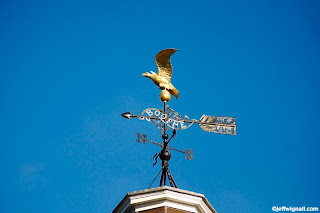
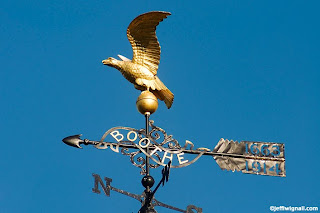 If there's one thing (optically speaking) that DSLR photographers always want more of it's a longer telephoto range. Even with the long telephoto lenses available (300mm is common with zoom lenses) and the fact that these lenses are even more powerful on a camera with a cropping factor, there's always a desire to have longer and longer lenses. And for certain types of photography like wildlife and sports, big telephoto lenses are a huge help, no question. It's nice to be able to fill the frame with a songbird across the yard, or a third-baseman across the field.
If there's one thing (optically speaking) that DSLR photographers always want more of it's a longer telephoto range. Even with the long telephoto lenses available (300mm is common with zoom lenses) and the fact that these lenses are even more powerful on a camera with a cropping factor, there's always a desire to have longer and longer lenses. And for certain types of photography like wildlife and sports, big telephoto lenses are a huge help, no question. It's nice to be able to fill the frame with a songbird across the yard, or a third-baseman across the field.
 For years, one of my hobbies other than photography has been metal detecting or, as it's sometimes called (sarcastically, I think) treasure hunting. Yes, I admit to being one of those geeks that walks along the beach with a $1,000 machine looking for dimes. And trust me, those coins aren't laying on the surface waiting for you to bend over and pop them into your pocket. You spend hours listening for the detector's friendly beep and digging a lot of false hits before you unearth the real deal. It's actually a very fun and interesting hobby and the first time you pull up an old silver coin out of the sand, you feel like running up and down the beach screaming, "I told you so! I told you so!" And I'm sure that some people do. (I just hopped around in a small circle for several minutes grinning and waving the dime.)
For years, one of my hobbies other than photography has been metal detecting or, as it's sometimes called (sarcastically, I think) treasure hunting. Yes, I admit to being one of those geeks that walks along the beach with a $1,000 machine looking for dimes. And trust me, those coins aren't laying on the surface waiting for you to bend over and pop them into your pocket. You spend hours listening for the detector's friendly beep and digging a lot of false hits before you unearth the real deal. It's actually a very fun and interesting hobby and the first time you pull up an old silver coin out of the sand, you feel like running up and down the beach screaming, "I told you so! I told you so!" And I'm sure that some people do. (I just hopped around in a small circle for several minutes grinning and waving the dime.)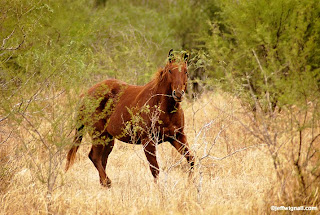 A lot of depth of field is a great thing if you want everything in your pictures to be in sharp focus. But there are times when you might want to limit or restrict depth of field so that only your main subject is sharply focused and the background and/or foreground is less sharp. The main reason for doing this is to accent your primary subject--in a head-and-shoulders portrait, for example--where you want your subject's face in sharp focus but want to toss the background into a soft blur.
A lot of depth of field is a great thing if you want everything in your pictures to be in sharp focus. But there are times when you might want to limit or restrict depth of field so that only your main subject is sharply focused and the background and/or foreground is less sharp. The main reason for doing this is to accent your primary subject--in a head-and-shoulders portrait, for example--where you want your subject's face in sharp focus but want to toss the background into a soft blur. There are really two kinds of sharpness in a photograph. One is the sharpness of your main subject, say, a person standing on the beach and that sharpness depends on how steady you were at holding the camera, the shutter speed you used, how carefully you focused on your subject and how still your subject was standing. If you are careful with your technique, your subject should be quite sharply focused.
There are really two kinds of sharpness in a photograph. One is the sharpness of your main subject, say, a person standing on the beach and that sharpness depends on how steady you were at holding the camera, the shutter speed you used, how carefully you focused on your subject and how still your subject was standing. If you are careful with your technique, your subject should be quite sharply focused. You probably wouldn't think it would matter how many of something you have in a particular photo, but whenever you're composing a group of things, whether it's pears, people, polar bears or pretty much anything else, compositions seem to work best with odd-numbered quantities. None of the composition books I have seems to offer a really solid reason why that's so (file it under "minor mysteries of the human brain"), but I think it's a good rule to follow. Whenever I'm arranging objects in a found still life or composing a landscape (three trees, five horses, etc.), I almost always seem to gather things in groups of three or five. There were about 50 sailboats in the harbor when I took this shot, clustered in little groups, some odd, some even, but the groups that looked best in the viewfinder always had odd numbers in them. Strange, isn't it? I think part of the problem with even-numbered groups is that the eye can easily divide the subjects into pairs and it starts to divide up the frame on some subconscious level. But whenever there are threes or fives, for example, they seem to adhere to one another in a way that unifies them. Try it sometime. Photograph groups of apples on your kitchen table and see if you like the odd groups better than the even ones. And if you figure out why the odds look better, let me know.
You probably wouldn't think it would matter how many of something you have in a particular photo, but whenever you're composing a group of things, whether it's pears, people, polar bears or pretty much anything else, compositions seem to work best with odd-numbered quantities. None of the composition books I have seems to offer a really solid reason why that's so (file it under "minor mysteries of the human brain"), but I think it's a good rule to follow. Whenever I'm arranging objects in a found still life or composing a landscape (three trees, five horses, etc.), I almost always seem to gather things in groups of three or five. There were about 50 sailboats in the harbor when I took this shot, clustered in little groups, some odd, some even, but the groups that looked best in the viewfinder always had odd numbers in them. Strange, isn't it? I think part of the problem with even-numbered groups is that the eye can easily divide the subjects into pairs and it starts to divide up the frame on some subconscious level. But whenever there are threes or fives, for example, they seem to adhere to one another in a way that unifies them. Try it sometime. Photograph groups of apples on your kitchen table and see if you like the odd groups better than the even ones. And if you figure out why the odds look better, let me know.
 When it comes to deciding if a subject is worth photographing or not, I think a lot of people (including most professionals) run the idea through a mental filter: Is this subject interesting or good enough to spend time photographing? Don't filter yourself. The one criteria you should use in deciding whether or not to photograph something is if it interests you. If something calls you and makes you want to photograph it, don't listen to the critics in your head, just listen to your imagination. These are, after all, your pictures and you get to decide what makes a good photograph. If you critique your ideas too much before you shoot them, you'll only stifle your imagination and give yourself another reason not to haul out the cameras and tripod and make the effort.
When it comes to deciding if a subject is worth photographing or not, I think a lot of people (including most professionals) run the idea through a mental filter: Is this subject interesting or good enough to spend time photographing? Don't filter yourself. The one criteria you should use in deciding whether or not to photograph something is if it interests you. If something calls you and makes you want to photograph it, don't listen to the critics in your head, just listen to your imagination. These are, after all, your pictures and you get to decide what makes a good photograph. If you critique your ideas too much before you shoot them, you'll only stifle your imagination and give yourself another reason not to haul out the cameras and tripod and make the effort.
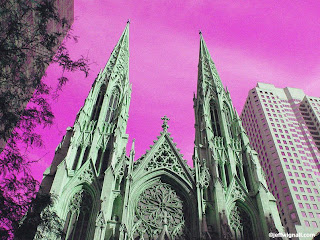 Way back in the pre-Photoshop days, photographers who wanted to get experimental with color had to get somewhat inventive in their technqiues. And since many of us grew up in the 1960's and were influenced by artists like Peter Max, we went to some pretty great extremes to intentionally scramble colors. The simplest method was to put colored filters over the lenses, but some photographers got more extreme and tried methods like duplicating negatives and slides (often through many generations) and filtering them during duplication, cross-processing film (developing slides films in chemistry meant for color negative films) or just messing around with colors in the darkroom.
Way back in the pre-Photoshop days, photographers who wanted to get experimental with color had to get somewhat inventive in their technqiues. And since many of us grew up in the 1960's and were influenced by artists like Peter Max, we went to some pretty great extremes to intentionally scramble colors. The simplest method was to put colored filters over the lenses, but some photographers got more extreme and tried methods like duplicating negatives and slides (often through many generations) and filtering them during duplication, cross-processing film (developing slides films in chemistry meant for color negative films) or just messing around with colors in the darkroom.

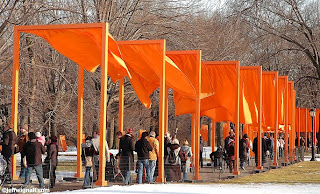 One of the most important ways to develop as an artist, whether art is your hobby, your passion or your profession, is to look at what other artists have done. It's impossible, I think, to be successful in any artistic medium (photography included), unless you know where other artists have taken it in the past. All art has a history and a progression and it's important to immerse yourself in that history whenever you get the chance. Most works of art are created to have a more or less permanent existence and there's hardly a town or a city where you won't find at least one museum to go visit and study and be near great art. But there are also artists who believe that art is best experienced as just that--an experience--and they create artworks that are more temporary in nature.
One of the most important ways to develop as an artist, whether art is your hobby, your passion or your profession, is to look at what other artists have done. It's impossible, I think, to be successful in any artistic medium (photography included), unless you know where other artists have taken it in the past. All art has a history and a progression and it's important to immerse yourself in that history whenever you get the chance. Most works of art are created to have a more or less permanent existence and there's hardly a town or a city where you won't find at least one museum to go visit and study and be near great art. But there are also artists who believe that art is best experienced as just that--an experience--and they create artworks that are more temporary in nature.
 It's fun to make travel photos more personal by including photos of the people you're traveling with in front of some of the landmarks that you're visiting together. Even if (like me) you prefer to rarely make an appearance in the photos yourself, you'll always be a part of the photos because you shot them. Taking pictures of your travel companions just standing there staring back at the camera can get old pretty fast, however, if you don't find some way to make the experience a bit more interesting for them and you.
It's fun to make travel photos more personal by including photos of the people you're traveling with in front of some of the landmarks that you're visiting together. Even if (like me) you prefer to rarely make an appearance in the photos yourself, you'll always be a part of the photos because you shot them. Taking pictures of your travel companions just standing there staring back at the camera can get old pretty fast, however, if you don't find some way to make the experience a bit more interesting for them and you. Well, OK, since it's "Black Friday" and everyone is talking about holiday shopping , I'll join the chorus and talk about book shopping or, more importantly, book giving (and that includes giving them to yourself). Since I was a kid I've always loved getting books as gifts and since I got seriously interested in photography in my teens, I've loved getting photo books. Fortunately my father was a photographer and my mother loved art and books. My mother also knew how much a single book could change someone's life and bring them the inspiration they needed. She was very good at finding just the right book for me at the right time in my life.
Well, OK, since it's "Black Friday" and everyone is talking about holiday shopping , I'll join the chorus and talk about book shopping or, more importantly, book giving (and that includes giving them to yourself). Since I was a kid I've always loved getting books as gifts and since I got seriously interested in photography in my teens, I've loved getting photo books. Fortunately my father was a photographer and my mother loved art and books. My mother also knew how much a single book could change someone's life and bring them the inspiration they needed. She was very good at finding just the right book for me at the right time in my life.